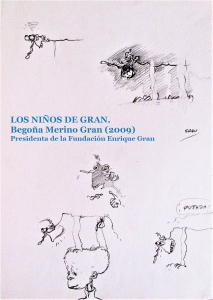Gran’s children. Begoña Merino Gran (2009)
Text produced on the occasion of the “Año Gran”, a programme of events and exhibitions paying homage to Enrique Gran on the 10th anniversary of his death.
THE GRAN’S “CHILDREN”
Enigmatic, visionary, bohemian, sober, silent, ironic, virtuous, intelligent, independent, exceptional, transcendent, vigorous, magical, melancholic, surprising, timeless, overflowing, unusual, revealing, mysterious, free, neo-romantic, delirious, intrasyncratic, brilliant
These are some of the adjectives chosen by great names of art and culture in our country, such as Francisco Calvo Serraller, Antonio Bonet Correa, Francisco Nieva, Santiago Amon, Juan José Millás, Antonio López, José Hierro, or Victor Erice…, to define Enrique Gran, whom they knew and with whom they shared great moments after leaving their native Cantabria.
But the genesis of this reference of the Spanish painting of the 20th century was already latent in an obsessive artist who arrived in Madrid with the illusion of drawing comics.
From “Arrows and Pelayo”, to Walt Disney’s “Three Knights”, as well as the small worlds of his own recurring characters, not only led him along a curious path to “ART with a capital M”, but also coexisted with his most monumental painting throughout a whole career lived by and for art.
Every emotion, situation, concern, anguish…, were immortalised by Gran in the form of notes or vignettes. A napkin, a sheet of newspaper or a convenient wardrobe door served as a support to give continuity to that parallel obsession that for him was the world of comics. To such an extent that it is impossible to understand Enrique Gran without delving into his most intimate and revealing facet, which describes his complex inner world in an unsurpassable way.
His marked and peculiar sense of humour, his particular romanticism and his taste for “playing at excess” in everyday life, explain the contrasting themes of his drawings, so full of irony, tenderness or “monstrosity”, starring beings that Gran himself describes with these words… And as for those individuals that I usually paint, they are tenants of their own atmosphere, and the most distorted humanoid types that “being and not being”, generate their light and their shadow.
All those who knew him intimately knew about this artistic “dripping”, which more than a form of expression was a need to de-dramatise and ironise about the meaning of life. In spite of this, such an important part of his artistic expression remained unpublished until 2005, six years after his fateful and almost novel death, surprising both the most fanatical followers of his painting and the general public.
Antonio López recently referred to this special talent at one of the meetings that the Ateneo de Santander dedicated to his memory as part of the “AÑO GRAN” events that various institutions from inside and outside Cantabria have programmed to commemorate the 10th anniversary of his death. In a magnificent intervention, the painter from Tomelloso asked himself “in what way, so natural from his beginnings as a painter, Gran extracted so much intensity, knowledge and expressive force, that he was already underlined as a dazzling artist, capable of returning to figuration better than Picasso himself”.
Finally, to insist that Enrique Gran’s interest in the world of comics, not only was not something anecdotal within his creative universe, but that his career cannot really be understood without the presence of his drawings or “his children”, as he used to call them, of whom one could well say that they are the everyday made art or the genius of making art an everyday thing.
Begoña Merino Gran. President of the Enrique Gran Foundation
Santander, 7 January 2009
